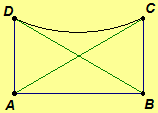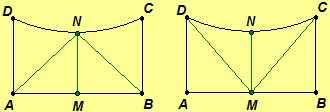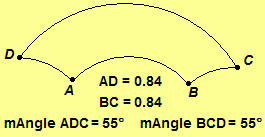2.6.2 Saccheri Quadrilaterals
 Printout
Printout
The value of non-Euclidean geometry lies in its ability to
liberate us from preconceived ideas in preparation for the time when
exploration of physical laws might demand some geometry other than the
Euclidean.
— Georg Friedrich Bernhard Riemann (1826–1866)
Georg Friedrich Bernhard Riemann (1826–1866)
 Euclid's
Fifth Postulate. That, if a straight line falling on two straight lines
make the interior angles on the same side less than two right angles, the two
straight lines, if produced indefinitely, meet on that side on which are the
angles less than the two right angles.
Euclid's
Fifth Postulate. That, if a straight line falling on two straight lines
make the interior angles on the same side less than two right angles, the two
straight lines, if produced indefinitely, meet on that side on which are the
angles less than the two right angles.
 Girolamo Saccheri (1667–1733), an
Italian Jesuit priest and mathematician, attempted to prove Euclid's Fifth Postulate from the other
axioms by the use of a reductio ad absurdum argument by assuming the negation of the Fifth
Postulate. In 1733, shortly before his death, he published a book
entitled Euclides ab omni nævo vindicatus ( Euclid Freed of Every
Flaw/Blemish), which represents some of the
earliest work in non-Euclidean geometry. He believed he had demonstrated the
result, but there were errors in his work where he had made additional
assumptions based on preconceptions. Due to Saccheri's knowledge of logic and care
in writing proofs, some believe that Saccheri knew of the errors. But left the
errors in the work so that the Catholic church would not prevent publication
since the results would have been in conflict with church doctrine of the time.
The book remained obscure until rediscovered by the Italian mathematician
Girolamo Saccheri (1667–1733), an
Italian Jesuit priest and mathematician, attempted to prove Euclid's Fifth Postulate from the other
axioms by the use of a reductio ad absurdum argument by assuming the negation of the Fifth
Postulate. In 1733, shortly before his death, he published a book
entitled Euclides ab omni nævo vindicatus ( Euclid Freed of Every
Flaw/Blemish), which represents some of the
earliest work in non-Euclidean geometry. He believed he had demonstrated the
result, but there were errors in his work where he had made additional
assumptions based on preconceptions. Due to Saccheri's knowledge of logic and care
in writing proofs, some believe that Saccheri knew of the errors. But left the
errors in the work so that the Catholic church would not prevent publication
since the results would have been in conflict with church doctrine of the time.
The book remained obscure until rediscovered by the Italian mathematician
 Eugenio
Beltrami (1835–1900).
Eugenio
Beltrami (1835–1900).
Saccheri considered a
certain type of quadrilateral, called a Saccheri
quadrilateral, as a basis for the beginning of his work in attempting to demonstrate
the Fifth Postulate. We consider Saccheri quadrilaterals here to show just how
close to the Euclidean concept of parallel lines one can arrive without
assuming the Fifth Postulate. Since the existence of a rectangle is equivalent
to Euclid's
Fifth Postulate, the idea is to show the existence of a rectangle. Note the
common properties of the Saccheri quadrilateral and a rectangle. In Euclidean
geometry, a Saccheri quadrilateral is a rectangle.
Definition.
A Saccheri
quadrilateral is a quadrilateral ABCD
where 


 and
and 


 are right angles and
are right angles and 


 .
Segment
.
Segment 


 is called the base, and segment
is called the base, and segment 


 is called the summit.
is called the summit.
A parallelogram is a quadrilateral in which
both pairs of opposite sides are
parallel.
A rectangle is a
quadrilateral with four right angles.
 Theorem
2.16. The diagonals of a Saccheri quadrilateral are congruent.
Theorem
2.16. The diagonals of a Saccheri quadrilateral are congruent.
Theorem 2.17. The summit angles of a Saccheri quadrilateral are congruent.
Proof. Given Saccheri
quadrilateral ABCD with right angles 


 and
and 


 ,
and
,
and 


 By Theorem 2.16,
By Theorem 2.16, 


 .
Since
.
Since 


 ,
,



 ,
and
,
and 


 ,
we have
,
we have 


 Hence
Hence 


 .
Therefore, the summit angles of a Saccheri quadrilateral are congruent.//
.
Therefore, the summit angles of a Saccheri quadrilateral are congruent.//
Theorem 2.18. The segment joining the midpoints of the base and summit of a
Saccheri quadrilateral is perpendicular to both the base and summit.
Proof. Given Saccheri
quadrilateral ABCD with right angles 


 and
and 


 ,
and
,
and 


 Further, assume M and N are the
midpoints
of segment AB and segment CD, respectively. Thus A-M-B, C-N-D,
Further, assume M and N are the
midpoints
of segment AB and segment CD, respectively. Thus A-M-B, C-N-D, 


 ,
and
,
and 


 Since the summit angles are congruent,
Since the summit angles are congruent, 


 Since
Since 


 ,
,



 ,
and
,
and 


 ,
we have
,
we have 


 Hence
Hence 


 Since
Since 


 ,
,



 ,
and
,
and 


 ,
we have
,
we have 


 Hence
Hence 


 Since A-M-B,
Since A-M-B,



 and
and 


 are a
linear pair. Since a linear pair of
congruent angles are right angles,
are a
linear pair. Since a linear pair of
congruent angles are right angles, 


 and
and 


 are right angles. Hence, by the
definition of
perpendicular lines, line AB is
perpendicular to line MN. A similar
procedure may be used to prove line CD
is perpendicular to line MN.
Therefore, segment MN is
perpendicular to both segment AB and
segment CD.//
are right angles. Hence, by the
definition of
perpendicular lines, line AB is
perpendicular to line MN. A similar
procedure may be used to prove line CD
is perpendicular to line MN.
Therefore, segment MN is
perpendicular to both segment AB and
segment CD.//
Theorem 2.19. The summit and base of a Saccheri quadrilateral are parallel.
Theorem 2.20. A Saccheri quadrilateral is a parallelogram.

It can be proven that the existence
of a rectangle is equivalent to
Euclid's
Fifth Postulate. Notice, Theorems 2.16


 2.20,
the properties that a Saccheri quadrilateral and a rectangle have in common.
But, the Saccheri quadrilateral is not a rectangle without a Euclidean parallel
postulate. For an example of a Saccheri quadrilateral that is not a rectangle,
consider the Saccheri quadrilateral in the Poincaré Half-plane on the right.
The summit angles at C and D are not right angles, since their
value is less than 90. The Poincaré Half-plane is a model of a hyperbolic
geometry in which it can be shown that the summit angles of a Saccheri
quadrilateral measure less than 90.
2.20,
the properties that a Saccheri quadrilateral and a rectangle have in common.
But, the Saccheri quadrilateral is not a rectangle without a Euclidean parallel
postulate. For an example of a Saccheri quadrilateral that is not a rectangle,
consider the Saccheri quadrilateral in the Poincaré Half-plane on the right.
The summit angles at C and D are not right angles, since their
value is less than 90. The Poincaré Half-plane is a model of a hyperbolic
geometry in which it can be shown that the summit angles of a Saccheri
quadrilateral measure less than 90.
Exercise
2.62.
Prove Theorem 2.16.
Exercise
2.63. Prove Theorem 2.19.
Exercise
2.64. Prove Theorem 2.20.
![]()
![]() Printout
Printout![]() Georg Friedrich Bernhard Riemann (1826–1866)
Georg Friedrich Bernhard Riemann (1826–1866)![]()
![]() Girolamo Saccheri (1667–1733), an
Italian Jesuit priest and mathematician, attempted to prove
Girolamo Saccheri (1667–1733), an
Italian Jesuit priest and mathematician, attempted to prove ![]() Eugenio
Beltrami (1835–1900).
Eugenio
Beltrami (1835–1900). ![]()
![]()
![]()
![]()
![]()
![]()
![]()
![]()
![]()
![]()
![]()
![]()
![]()
![]()
![]()
![]()
![]()
![]()
![]()
![]()
![]()
![]()
![]()
![]()
![]()
 Theorem
2.16. The diagonals of a Saccheri quadrilateral are congruent.
Theorem
2.16. The diagonals of a Saccheri quadrilateral are congruent.![]()
![]()
![]()
![]()
![]()
![]()
![]()
![]()
![]()
![]()
![]()
![]()
![]()
![]()
![]()
![]()
![]()
![]()
![]()
![]()
![]()
![]()
![]()
![]()
![]()
![]()
![]()
![]()
![]()
![]()
![]()
![]()
![]()
![]()
![]()
![]()
![]()
![]()
![]()
![]()
![]()
![]()
![]()
![]()
![]()

![]()
![]()
![]()
![]()
![]()
![]()
![]()
![]()
![]()
![]()
![]()
![]()
![]()
![]()
![]()
![]()
![]()
![]()
![]()
![]()
![]()
![]()
![]()
![]()
![]()
![]()
![]()
![]()
![]()
![]()
![]()
![]()
![]()
![]()
![]()
![]()
![]()
![]()
![]()
![]()
![]()
![]()
![]()
![]()
![]()
![]()
![]()
![]()
![]()
![]()
![]()
![]()
![]()
![]()
![]()
![]()
![]()
![]()
![]()
![]()
![]()
![]()
![]()
![]()
![]()
![]()
![]()
![]()
![]()
![]()
![]()
![]()
![]()
![]()
![]()
![]()
![]()
![]()
![]()
![]()
![]()
![]()
![]()
![]()
![]()
![]()
![]()
![]()
![]()
![]()
![]()
![]()
![]()
![]()
![]()
![]()
![]()
![]()
![]()
![]()

![]()
![]()
![]()
![]()